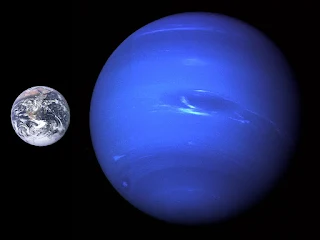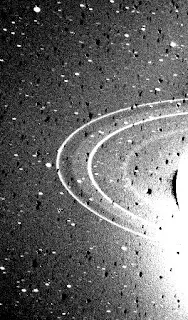SOLAR SYSTEM FAMILY-FACTS ABOUT NEPTUNE, THE FARTHEST PLANET
With the continuous evolution of astronomical techniques, we have come to know that our solar system is a family of eight major planets with their natural satellites, followed by hundreds of thousands of minor planets, asteroids and comets. Before the invention of the telescope by Galileo, the early astronomers could only see the five planets from Mercury to Saturn. It was not until very recently we found that our solar system is much larger than previous estimates. By the mid 17th century, astronomers already observed the five known planets with the help of their telescopes. And something told them that there were more things out there. And finally, by mid 19th century, after the discovery of Uranus, another planet named Neptune joined the list.
Discovery and Naming: Because of its extreme distance from the Sun, Neptune is not visible with the unaided eye and as a result, the planet was discovered with the help of mathematical calculations, contrary to standard telescopic observations. Although Galileo Galilei was aware that the star which he had observed was not fixed like the background stars, his telescope was not powerful enough to discern it as a planet. John Herschel, the son of William Herschel, almost discovered the planet while conducting some observations in 1830, but he unfortunately mistook it as a star. From 1821, astronomers like Alexis Bouvard, John Couch, Sir George Airy, and Urbain Le Verrier developed calculations and tables regarding the orbit of Uranus. But observations with a telescope revealed some discrepancies in their calculations which could only be explained by the presence of another planet. Finally, on the evening of 23rd September 1846, a new planet was observed by Johann Gottfried Galle upon the suggestions given by Le Verrier.
The planet was named Neptune, after the Roman god of the sea whose counterpart was Poseidon in Greek Mythology.
Basic Facts: Neptune is the farthest, and also the fourth largest planet of our solar system. Being situated at a whooping distance of 30 AU or 4.5 billion kilometers from its parent star, this distant world is an ice giant just like Uranus. It has got 14 moons, a system of ring, an extremely violent atmosphere and is by far, the windiest place in our solar system. Unlike Uranus's cyan blue colour, the Neptunian atmosphere takes on a deep blue and scientists are not sure about the underlying mechanism.
 |
| The Farthest Planet/Image Credits: NASA, Public domain, via Wikimedia Commons |
Planetary Characteristics:
- Orbital & Rotational Characteristics: Neptune orbits the Sun at an average distance of 30 AU, with an orbital period somewhat equal to 165 Earth years. Due to an orbital eccentricity of 0.008, its perihelion and the aphelion distance varies between 29.81 AU to 30.33 AU. Just like Jupiter exerts a tremendous influence upon the asteroid belt, Neptune also does the same on a much larger belt of debris, known as the Kuiper Belt which extends from 30 AU up to 55 AU. The dwarf planet and a Kuiper Belt object, Pluto, has an eccentric and inclined orbit, which brings the former inside the orbit of Neptune. Although their orbits intersect each other, the two can never collide because of their 3:2 orbital resonance i.e., for every three orbits of Neptune, Pluto completes only two. Thus, Pluto remains closer to the Sun for a period of 20 years for every 248 Earth years. Neptune has an axial tilt of 28.32° which is similar to the tilts of Earth and Mars. Thereby, the former experiences seasons that last for nearly 40 Earth years due to its long orbital period. As the planet is made up of gas and ice, its atmosphere undergoes differential rotation and the polar regions rotate faster than the equatorial zones. However, the planet has a rotational period of nearly 16 hours.
- Internal Structure & Composition: Neptune's interior is similar to that of Uranus, and is composed of 80% hydrogen, 19% helium, 1.5% methane, and trace amounts of ethane, hydrogen deuteride, followed by large quantities of water ice and ices of ammonia. Just like a typical gas or ice giants, instead of a solid surface, Neptune's gaseous atmosphere gradually transitions into a dense and hot fluid of water-ammonia, which is further followed by a mantle of ionic to superionic water, and finally, deep below there is a solid core supposedly made up of iron, nickel and silicates. It has also been hypothesized that below the dense Neptunian atmosphere, pressure and temperature are so great that molecules of methane decompose and the carbon separates to condense into diamond crystals. As a result, chunks of diamond rains down upon the fluid interior in the form of hailstones, albeit expensive hails indeed. This type of diamond rain might also occur in Jupiter, Saturn and Uranus.
 |
| Just a different shade of blue/Image Credits: NASA (image modified by Jcpag2012), Public domain, via Wikimedia Commons |
- Atmosphere: Although Neptune and Uranus have similar atmospheric compositions, the former assumes a vivid blue color contrary to the pale cyan of the latter, and the exact reason for this bright and deep blue coloration is not known. Again, in spite of being situated that far from the Sun, the Neptunian atmosphere is a hostile region with wind speeds reaching the mark of 2,200 km/h, which are even stronger than those of Jupiter. The atmosphere has been subdivided into the troposphere, stratosphere, thermosphere and the exosphere, where the cloud composition varies with pressure and temperature. Neptune experiences dynamic storm systems, cyclones and anticyclones, followed by intense weather activity, like the ''Great Dark Spot'' which was observed during Voyager 2's visit. That storm system was large enough to accommodate our whole planet and leave some space for other little bodies. Since then, other dark spots also appeared in addition to prominent cloud bands and vortices.
 |
| The Great Dark Spot and the Small Dark Spot/Image Credits: Photo by form PxHere |
- Magnetosphere & Magnetic Field: Like Uranus, Neptune's magnetosphere is not aligned with its rotational axis and is tilted by 47 degrees, while the magnetic centre is offset by about 13,500 km from the planet's physical centre. This tilted field is probably due to their fluid interiors rather than a result of some collision with other bodies. The magnetosphere is strong enough to protect the planet from the incoming solar plasma and the magnetotail extends much farther.
- Ring System: Neptune has a thin system of rings, composed of particles of ice, silicates and carbon compounds. The prominent rings are the Galle, Le Verrier, Lassell, Arago, and Adams, which extends for 42,000-62,000 km from the planetary centre.
- Natural Satellites: By far, Neptune is known to possess 14 moons, which are believed to be formed from the accretion of the sub-nebula around the young planet while some of them might be captured objects. The inner or the regular satellites include Naiad(diameter=60 km), Thalassa(diameter=81 km), Despina(diameter=156 km), Galatea(diameter=174 km), Larissa(diameter=194 km), Hippocamp(diameter= 34.8 km) and Proteus(diameter=420). The list of irregular or outer moons include Triton(diameter=2705 km), Nereid(diameter=357 km), Halimede(diameter=62 km), Sao(diameter=44 km), Laomedeia(diameter=42 km), Psamathe(diameter=40 km) and Neso(diameter=60 km), of which Triton being the largest Neptunian satellite deserves special mention. Triton was discovered by William Lassell in 1846 and was later found to be the seventh largest moon in our solar system. It has an icy surface covered by ices of water, methane, nitrogen and carbon dioxide and is one of the coldest bodies with a surface temperature around 38 K(-232℃). It has a substantial atmosphere made of nitrogen and small amounts of methane and carbon dioxide. Some of Neptune's moons have a heavily cratered surface, while others have porous and rubble-like surfaces as they are mostly made of ice and very little rock. The nearest moon, Naiad is situated at a distance of 41,900 km while the farthest, Neso can stay as far as 66 million km from the planet's centre.
 |
| Triton, the largest moon of Neptune/Image Credits: NASA / Jet Propulsion Lab / U.S. Geological Survey, Public domain, via Wikimedia Commons |
Life & Biological Characteristics: Life as we know it may not survive the harsh Neptunian conditions and there are probably no alien beings out there.
Explorations: Voyager 2 is the only space probe to have explored Neptune up close and as of today there have been no mission to this distant planet. When the probe reached the Neptunian system in August, 1989, scientists were able to gather a load of data about the planet's weird magnetosphere, dynamic atmosphere, strong winds, cyclones and the Great Dark Spot, in addition to data on the Neptunian moons.
Some Quick Facts:




Comments
Post a Comment